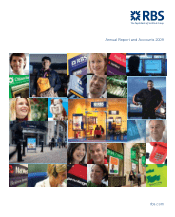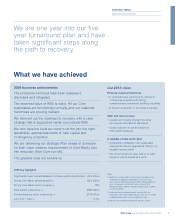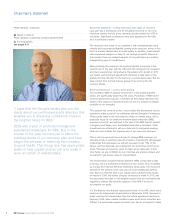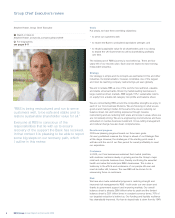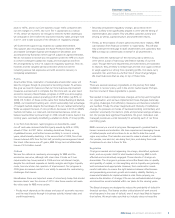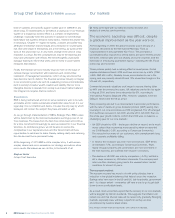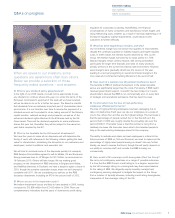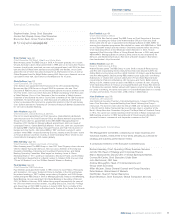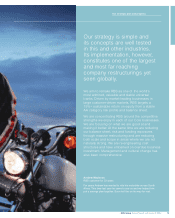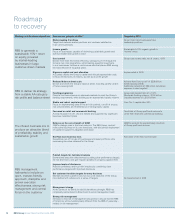RBS 2009 Annual Report Download - page 8
Download and view the complete annual report
Please find page 8 of the 2009 RBS annual report below. You can navigate through the pages in the report by either clicking on the pages listed below, or by using the keyword search tool below to find specific information within the annual report.
RBS Group Annual Report and Accounts 20096
Our marketsGroup Chief Executive’s review continued
The economic backdrop was difficult, despite
a gradual improvement as the year wore on.
At the beginning of 2009, the global economy was in the grip of a
recession described by the International Monetary Fund as
“unprecedented in the post-World War II era”. This prompted a
coordinated policy response by central banks and governments around
the world. Interest rates were cut sharply and some countries took the
extra step of introducing quantitative easing – including the UK. Fiscal
policy was also loosened.
These policies quickly had a calming effect on asset prices. Global
equities stabilised in March 2009 and have since risen by c.65% (FTSE
+45%, S&P 500 +55%). Similarly, house prices started to rise in the
spring, and are presently about 5% and 10% above their troughs in the
US and UK, respectively.
Commercial property valuations took longer to recover. Having fallen
by 44% over the previous two years, UK valuations started to rise again
in August 2009, and have since rebounded by 9%, according to
International Property Databank (IPD). However, valuations were still
falling in Ireland and the US as at Q4.
Policy loosening also led to an improvement in economic performance,
with the rate of decline in gross domestic product (GDP) easing, then
reversing in our core economies as 2009 progressed. The US emerged
from technical recession in Q3 2009, and the UK in Q4 2009. Even so,
the whole year growth outturns confirm that 2009 was, on balance, a
challenging year for our core markets:
•UK GDP shrank by 4.8% – the largest decline on record, and a much
worse outturn than economists were expecting when we reported
our 2008 Results (-2.6%, according to Consensus Economics).
The recession hurt many of our customers, with unemployment rising
and corporate profitability falling.
•In Ireland, the recession was even more pronounced. GDP fell by
an estimated 7.3%, according to Consensus Economics. That’s
mainly because property and construction are more prominent in
the Irish economy, and suffered even sharper corrections.
•The decline in US GDP was mild by comparison (-2.4%), but that is
still a deep recession by US historic standards. The unemployment
rate more than doubled, giving rise to the weakest labour market
conditions for almost 30 years.
The economic outlook
The nascent recovery has more to do with policy stimulus than a
reduction in the global imbalances that helped cause the recession.
Savings rates have risen in the US and UK, but households, government
and – to a lesser extent – companies still have a way to go to get debt
down to more comfortable levels.
As a result, most economists expect that the recovery in our core markets
will be sluggish by historic standards. This suggests that inflation will
remain low and that interest rates will be raised only gradually. Emerging
markets, especially Asia, will likely outperform as they are less
encumbered by balance sheet strains.
N.B. All data are from Thomson Datastream, unless otherwise indicated.
MKeep up-to-date with our latest economic research and
analysis at www.rbs.com/economics
level of systemic and specific support called upon in 2008/09 in any
future crisis. To enable banks to fail without a seizing-up of our financial
system or a disastrous domino effect is a complex re-engineering
challenge, especially when the scenario in question is not individual
bank failure but systemic threat to many banks. I believe the answer lies
in devising a ‘Chapter 11’ regime for banks, a clearer and swifter loss
attribution mechanism beyond equity and a reduction in counterparty
risk. Size and shape of themselves are a red herring, as surely all the
facts of the crisis bear out. In any event, change in the area of crisis
resolution is a must. But the consequences may be far-reaching and
may have unforeseen side effects. We need thoughtful, purposeful
dialogue leading to reform that works and we need to avoid rushed
measures that distract.
Finally, the financial services industry must do more on the issue of
cultural change: reconnection with customers and communities;
restoration of management excellence; reform of pay structures that
have become hard to defend. The financial services industry is integral
to our economic system. As such its weakening comes at considerable
peril to society’s broader wealth creation and stability. But our more
intangible licence to operate from society is at present rather battered.
Our integral role requires that we restore it.
Shareholders
RBS is being restructured and run to serve customers well, to be safe
and stable and to restore sustainable shareholder value for all. It is our
legal duty. It is our intention and desire. It is also the only way by which
taxpayers will recover the support they have entrusted us with.
As we go through implementation of RBS’s Strategic Plan, RBS’s value
will be determined by the improved sustainable earnings power of our
Core business. The losses from the Non-Core wind-down will continue
for a time, but should increasingly be seen as catered for in our financial
structure. As confidence grows, we will be able to resolve the
complexities in our capital structure and the Government will have
opportunities to sell down its stake, thereby adding clarity and reducing
the risk discount that is perceived today.
At the beginning of 2010 RBS is still a complex story. It will become
simpler, clearer and more valuable as our strategy and actions show
more results. We believe we can do this, to the benefit of all.
Stephen Hester
Group Chief Executive

